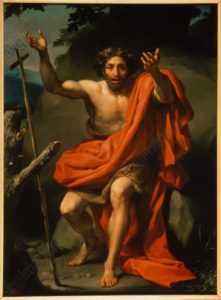John the Baptist
Anton Raphael Mengs 1728-1779.
“Repent, for the Kingdom of God is at hand.”
Mount Calvary Church
A Roman Catholic Parish
The Personal Ordinariate of S. Peter
Eutaw Street and Madison Avenue
Baltimore, Maryland
December 8, 2019
Advent II
Rev. Albert Scharbach, Pastor
Dr. Allen Buskirk, Choirmaster
Midori Ataka, Organist
8:00 A.M. Said Mass
10:00 A.M. Sung Mass
Brunch to follow in the undercroft
_______________
Organ Prelude
Gott, Durch Deine Güte / Gottes Sohn ist Kommen, J. S. Bach
Organ Postlude
Fantasia, Johann Krieger (1651-1735)
_________________
Common
Anglican Folk Mass, Shaw
_________________
Anthems
Domine, praestolamur, William Byrd (1540-1623)
Domine, praestolamur adventum tuum, ut cito venias, et dissolvas jugum captivitatem nostrae.
O Lord, we await thy coming, that thou come quickly and dissolve the bonds of our captivity.
“Domine praestolamur” is a setting of the text for the matins responsory during Advent in the Sarum rite. This anthem was published in 1589 in a collection of five-part Latin motets by William Byrd. The music is in the aeolian mode, which sounds to modern ears like the key of A minor, as befits the solemn text depicting our waiting in captivity for the advent of the Lord and for his deliverance. As is common in the high renaissance style, the piece begins with the same motif sung by each voice at its entrance (a point of imitation). This piece is remarkable because it employs a double imitative technique: in the first phrase “Domine praestolamus adventum tuum” the two first words are matched with one musical motif whereas the second two words are matched with an independent musical motif: two imitative entries for a single phrase of text. Near the end of the anthem, listen for the phrase “captivitatis nostrae” that circles around the same notes, depicting captivity, and how the following phrase “et dissolvas jugum,” dissolving the yoke, is set to a rising melody with a strong sense of forward motion, depicting our liberation.
_________
Like as the hart, Herbert Howells (1892-1983)
Like as the hart desireth the waterbrooks, so longeth my soul after thee, O God. My soul is athirst for God, yea, even for the living God. When shall I come to appear before the presence of God? My tears have been my meat day and night, while they daily say unto me, “Where is now thy God?”
“Like as the hart” is a mysteriously foreboding setting of the first three verses of Psalm 42 by Herbert Howells (1892-1983). The music was written in a single day in January 1941 while Howells was snowed in at Cheltenham while London was under nearly constant aerial assault. It was published in a series of four anthems “in time of war.” Marked “with quiet intensity,” the piece opens with a lyrical melody in the men’s voices, colored with a pointed chromaticism. The whole chorus enters with the plea “When shall I come to appear before God?” that slowly dies away into a quiet E minor. In the middle section, the pace picks up with a soprano solo answered dramatically by the chorus, “Where is now my God?” After the sopranos and tenors pass this melody back and forth, the first melody returns, now answered in counterpoint by the sopranos. Listen for the plaintive notes in the organ that haunt the final chord sung by the choir. This anthem highlights the longing for the coming of the presence of God characteristic of the Advent season.
_________________
Hymns
On Jordan’s Bank is a translation of a Latin hymn by Charles Coffin (1676—1749 Paris), who was a French teacher, writer, Jansenist, and Rector of the University of Paris. The translator, John Chandler (1806—1876) was an Anglican clergyman who translated hymns of the early church and hymns from the Paris Breviary of 1736, in which this hymn appeared. The text sums up the message of John the Baptist, encapsulating each of the important themes of the Forerunner of Christ: announcement of grace, expectancy for the coming Messiah, and renewal in preparation for the coming of the King. The first stanza calls God’s people to give attention to the coming Christ. The second calls people to receive God’s presence and God’s cleansing from sin. The third is a profession of faith in Christ. The fourth is a prayer for God’s continued grace in our lives and in our world—a response to God’s redeeming Word. The fifth is a doxology of praise.
Prepare the way, O Zion (Modern lyrics) is by the Swedish bishop Frans Michael Franzén (1772-1847). It was translated by Augustus Nelson (1863–1949). This joyful song celebrates Christ who comes to destroy sin and death, not by violence, but by his birth as a child and his self-giving on the cross.
Hark, a thrilling voice is sounding is a translation by Edward Caswell (1814–1878) of the Latin hymn, Vox clara ecce intonat. It is based on Romans 13: 11-1. We hear that “Christ is near”; in response, we “cast away the works of darkness.” Advent is not a passive season but demands something from us. We sing of “The Lamb, so long expected, comes with pardon down from heaven. Let us haste, with tears of sorrow, one and all, to be forgiven.” Advent, like Lent, is a season of repentance, and repentance involves action. Just as Christ came 2,000 years ago, we know he can come again even tomorrow as the next stanza reminds us, “So when next He comes in glory and the world is wrapped in fear, He will shield us with His mercy and with words of love draw near.” By confession and repentance, we prepare to meet the Lord.
